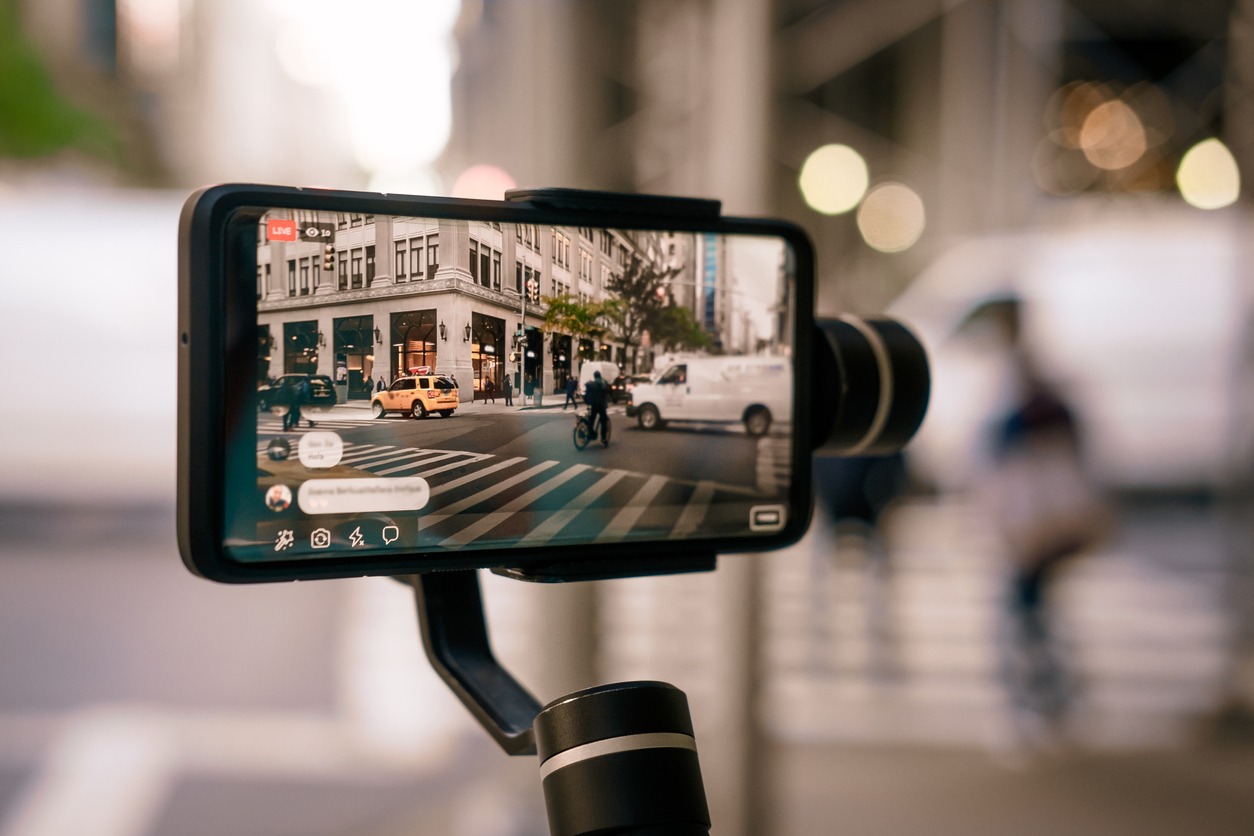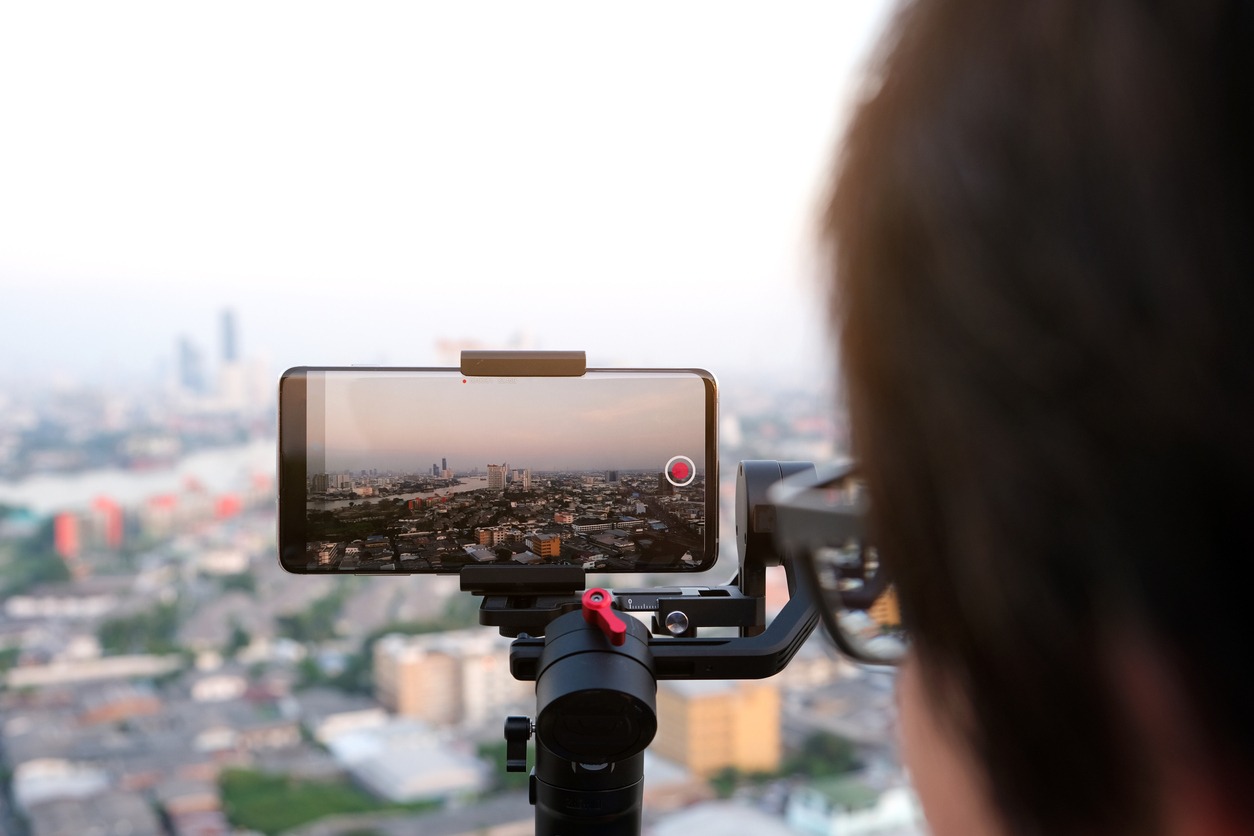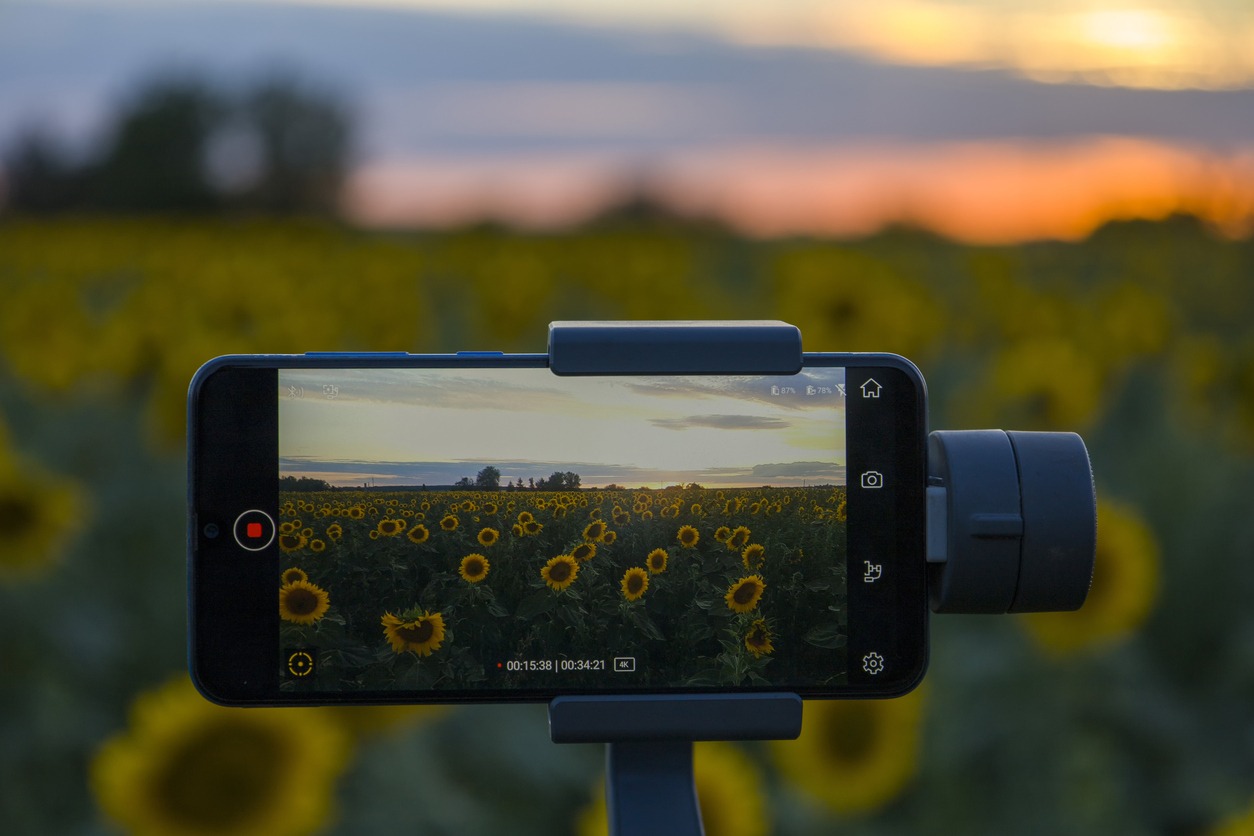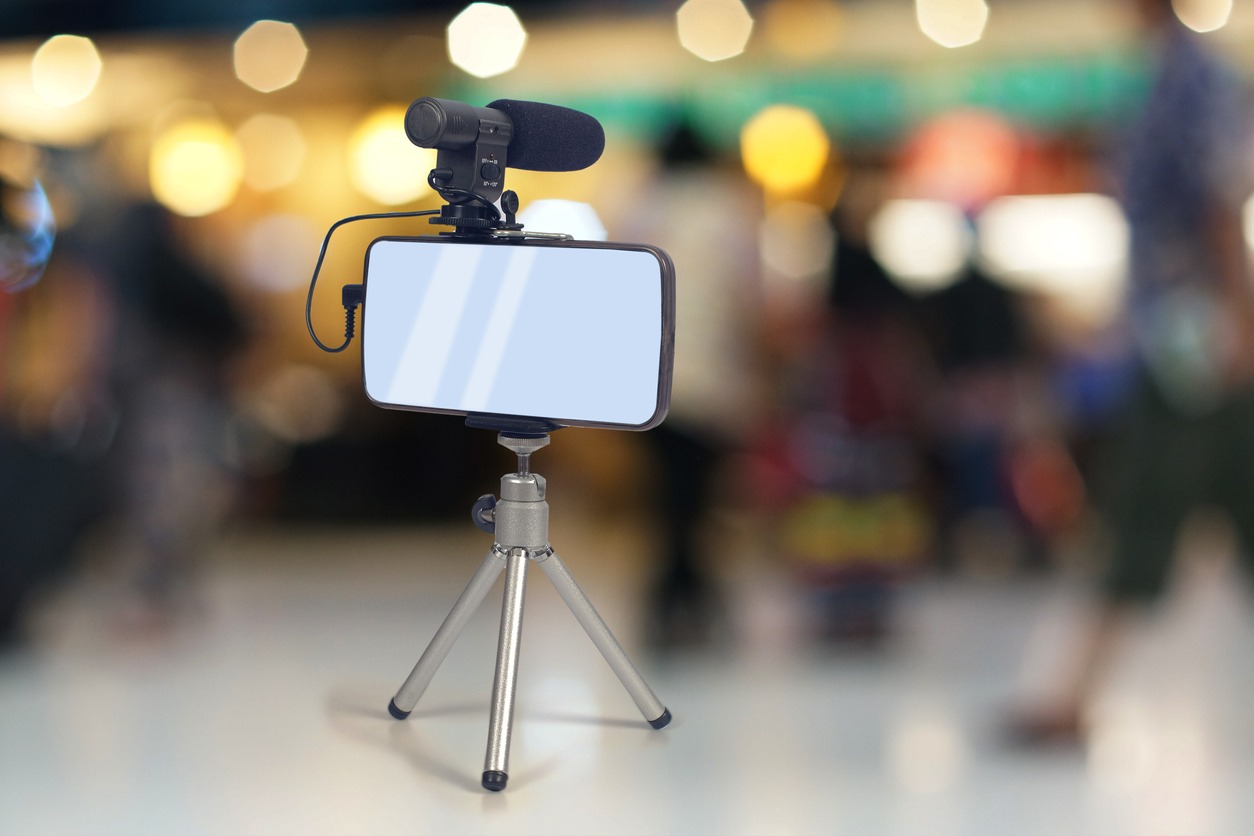What Is Smartphone Cinematography?
Smartphone cinematography is the art of using just your phone to take high-quality videos. Recently, smartphone cameras have massively improved in quality, which is why many prefer them over purchasing expensive gear.
The smartphone industry has revolutionized cinematography, making the art more accessible. Now, everyone can pick up their phone and shoot a cinematic video. Camera lenses have also advanced so much that you can effortlessly produce high-quality videos without purchasing expensive equipment.
There are also various apps available that you can use to edit your final video and make it look aesthetically pleasing. Smartphone cinematography is an excellent way to get acquainted with filmmaking as it allows you to experiment and get your bearing.
How To Shoot Cinematic Videos on Your Phone
With the rise of mobile filmmaking, more people have started to explore the field as they can experiment by only using their phone cameras. Although phone cameras have received a massive upgrade over the years, shooting that perfect video takes some practice and time.
If you want to get started with cinematography using your phone, here is how you can achieve the best results.
-
Know Your Phone’s Limitations
Modern smartphones use extremely powerful lenses and the newest technology to help you shoot aesthetic and cinematic videos. However, they cannot compare to a professional camera. The main feature that is affected when using a phone to film cinematic videos is dynamic range. Camera sensors in phones also have a limited range and cannot handle too bright or dark scenes.
After a certain level of brightness, the camera will record white. If the scene is too dark, the video will have too much noise and will essentially be useless.
The camera’s dynamic range is determined by how well the sensor performs in low light and can reduce noise in shadows. Phone camera sensors are generally limited in dynamic range.
-
Consider Using an App
One of the first things you should do before you attempt to shoot a cinematic smartphone video is to purchase a video camera app from the AppStore or Play store. Pro video camera apps are extremely helpful as they give you manual control over your camera. You can use this newfound freedom to record at a maximum bit rate to improve your video quality.
It is recommended that you shoot at UHD 4K at maximum bitrate, measured at 100 – 150Mbps. You should also save the 1080p high frame rate setting and use it for specific unique shots.
You can also use the app you download to manually adjust the ISO and shutter speed, which will help you get that perfect shot.
-
Choose an Appropriate Date and Time for Perfect Lighting
When shooting videos outside, carefully choose a time to get the perfect lighting for your video. Having good lighting when shooting a video means you can fiddle around with the colors in post-production and make the video look even better. If your lighting is not good while filming, fixing exposure problems in post-production can be extremely difficult.
If you shoot in a bright setting, you risk overexposing the image or video, which is impossible to fix. Thus, it would be best if you took special care to shoot when the sun is setting or is not high in the sky. The best way to keep your exposure balanced is to shoot outdoor shots in the early morning, late afternoon, or early evening. If the day is overcast, you can shoot at any time of the day.
-
Set Your Exposure
When shooting videos on a phone camera, you need to be very mindful of the exposure. If you are not careful, you can overexpose an image, leading to the end result being a white screen.
You can sometimes capture the light and contrast in your scene perfectly. However, in some cases, you may have to choose whether to retain details in the shadows or the highlights. You can also aim to find a middle ground.
If your phone camera has a fixed aperture, you will need to change the settings of your ISO and the shutter speed to get a shot with perfect exposure.
-
Set Your ISO
ISO is your camera’s sensitivity to light. The higher the camera’s ISO, the more sensitive it is to light. The lower the ISO, the less sensitive the camera is to light. ISO ratings on phones range from 100 to 800. Thus, you can take shots in dim and bright light by changing the ISO.
The ISO can be changed using a pro video camera app that allows you to tinker with your phone’s camera settings. Phone cameras are much better suited to filming shots in bright light than low light.
-
Set Your Shutter Speed
When using your phone to film a cinematic video, you may have to compromise on the shutter speed. For cinematic videos, a 180-degree shutter angle is the best. If you shoot at 24fps, the shutter speed will be 1/48th sec. At 25fps, it will be 1/50th sec; at 30fps, it will be 1/60th sec.
You can use an ND filter to alter shutter speeds and place it in front of the camera lens to adjust shutter speeds. This method is much easier if you use an external lens system. You can also use an IRND filter and hold it against the back of the phone.
-
Keep Your Phone Steady
Before you hit the record button, your phone must be stable. The more stable and smooth the shot is, the better it will be perceived. Smooth shots also reduce distractions, and the viewer can enjoy the scene in front of them.
There are many tools on the market that you can use to stabilize your phones, such as gimbals. Some gimbals are designed to follow your face and pan across the space using their ball joint. Stabilization can also be achieved in post-production.
-
Frame Your Shot
When shooting your video, remember all the rules for framing and composition. The rules do not change whether you use a phone or a professional camera. Ensure that your shot has different angles and plenty of symmetry and reflection. These features make a shot exciting and unique.
Smartphones are compact and lightweight, which gives you a lot of flexibility to move them around in whichever position gets the best shot. An excellent way to make your video enjoyable is by adding a simulated shallow depth of field. To do so, you must frame the foreground objects close to the lens. This throws the background out of focus, creating an exciting shot.
-
Focus on the Subject
Ensure that the focus on the subject is sharp. Focus is critical in cinematography as it allows the users to know what they have to focus on and where the subject of the video is. If you use autofocus, you may face some difficulties in low-light situations. Therefore, it will serve you well to switch to a manual focus. You can do so through pro video apps.
-
Film at the Highest Possible Quality
When filming, professionals suggest that it is best to film at the highest possible quality and then downsample it later. The highest possible with a phone is 2160p. Filming at the highest possible quality allows you to stabilize and crop your shots in post-production without losing the quality. Cropping and editing in 2160p material in a 180p timeline is extremely easy, and the end product ends up looking fantastic.
-
Do Color Grading and Correction
Once you have shot your video with good exposure, interesting angles, and sharp focus, you can color-correct the video to add cinematic quality. Color correction allows you to fix any imbalances in the color so that the viewer can see it as it was meant to be. Many different color grading or correcting software are available on the AppStore and Play store.
Some Tips To Improve Your Smartphone Cinematography
Smartphone cinematography has seen a sharp incline, with phone cameras improving each year. Alongside the hardware, video editing software have also become much more accessible.
However, you must know how to work your camera to create a film or an aesthetically pleasing video. Even though the tools may be readily available, you need to practice and sharpen your skills. One easy way to learn is to take advice from professionals, focus on the tips they give, and aim to apply them in your work.
-
Switch Up Your Camera Settings
To film a cinematic video from your phone, you only need to know about and change a few settings. The first setting that you should change is the camera’s resolution. Ensure that your phone is shooting in its highest resolution. Doing so will give you the best shot that you can later edit if needed.
You should also shoot at a higher frame rate. Ideally, you should choose a frame rate higher than 24. If you intend to film slow motion, you must change your frame rate to 60 fps to get a smooth shot. Slow motion is greatly appreciated because it makes the video seem much more dramatic and interesting.
The third setting that you should change is exposure. Set your exposure to where the shadows and highlights are balanced in a particular space and lock it. Suppose you choose to leave your exposure on auto. In that case, the video will fluctuate and change the overall brightness, which will be distracting to the viewer.
Additionally, if needed, you should also lock the focus to avoid losing the focus. If your camera loses focus halfway through a shot, the video may become blurry and unusable.
-
Have a Storyline
An excellent way to ensure that you know your video’s direction is to have a mood board. Many professionals use it to decide a shot’s composition and flow. A mood board also allows you to decide on angles and perspectives that you can incorporate to improve the cinematic quality of your video.
Having a storyline gives you an alignment and direction to take each scene and frame, making the entire filming process much easier.
-
Always Shoot in Landscape Mode
When shooting a film, always film in landscape mode because it allows you to capture a lot more detail and make the shot look professional. Portrait mode is what most people choose when filming on their phones because of the dimensions of the phone. However, if you plan to export the film to a larger screen and use it for a project, film it in landscape mode.
Landscape mode also eliminates the black bars on either side of your frame if you shoot a video in portrait mode. While shooting in landscape, there are various ways that you can add texture and variety to your shots. You can change up the angle and the perspective. Some shots can be zoomed in, while others zoomed out, etc.
-
Use Timelapses
Timelapses are an entertaining way to bring the viewer’s attention to a single scene by changing up its pace. When a video is filmed in time-lapse mode, the video’s pace is faster. So, a video filmed over an extended period is condensed into a smaller time frame.
Using time-lapse, you can show the passage of time by recording a video for long periods such as hours, days, months, or years and condense it.
-
Keep Your Shot Steady
When shooting using your phone’s camera, ensure that the camera is stable, and the motion is smooth when panning. When shooting cinematic films using your phone, you have to hold the phone with your hands, and it is unlikely that you will be able to keep it completely stable.
If your film has a lot of shaky camera movements, it will distract the viewers from the film’s main focus, and the shot may appear amateur. There are many different cameras and phone accessories available on the internet that you can use to stabilize your shots.
Tripods and gimbals are the most common way, as they free up your hands and enable you to capture a stable shot. A gimbal head is often attached to a tripod head or comes as a separate device designed to move around smoothly. Some gimbals are made to follow your motion and ensure that the subject is always in frame and is the main focus.
Some smartphone cinematographers also prefer to use a grip rig. This accessory is a handheld stabilizing device that you can attach to your phone to the grip rig and hold the rig itself to reduce shakiness.
-
Ensure the Audio Is Clear
Clear audio is a must for camera cinematography because if your shot is visually perfect but has a lot of noise in the background, it will distract the viewer. Additionally, if you are filming a human subject with dialogue, you should invest in external microphones.
Smartphones are thin devices that are not designed to house professional microphones. The microphones that phones do have are enough to capture your voice, but it does not do an excellent job of eliminating environmental noise.
Suppose you want to increase the sound quality of your phone. In that case, you should purchase an external microphone for your smartphone. This accessory will help provide crisp audio that is clear and audible for the viewers.
-
Backup Batteries
Smartphones usually have very small batteries that are not designed to be used for hours on end. Most phone batteries can last you a day on light usage and are thus unsuitable for extensive filming. However, suppose you plan on filming cinematic videos on your camera. In that case, you need a backup battery to charge your phone if it runs out of charge.
Furthermore, try to charge your phone beforehand and invest in a wireless charger that allows you to film even if your battery is low.
-
Use External Storage Devices
When you use your smartphone to film cinematic shots, the videos will initially save on your phone. If you need more space, you should invest in external storage devices. These devices are much more reliable than saving film on your phone and risking it getting lost or accidentally deleted.
Phones also have limited storage, so you may run out of storage, and all your shots may never get saved.
Pros and Cons of Filming Using Your Phone
| Pros | Cons |
| Phones are compact and light. | They have low dynamic range |
| They are portable, so you can carry them around with you. | Even if you have the option to control your image, you cannot reach the quality that professional cameras offer. |
| There are many apps on the Playstore and Appstore that give you more control over the camera settings. | They have a tendency to overheat. |
| You can find many accessories, such as camera stabilizers, lenses, etc., for your phone. | They have small batteries that last only a short time. |
| They are always with you. |
FAQs
-
How can I make my phone footage look cinematic and aesthetic?
You can edit the footage and color grade it. Additionally, you should also ensure that the lighting is perfect. To further improve your shots, shoot at 24fps, apply a cinematic crop, and use timelapse and slow-motion options.
-
Can you shoot a professional video with a phone?
Yes, you can shoot professional videos using your phone camera because many apps allow you to adjust your camera settings. Furthermore, smartphone cameras have significantly evolved and can shoot at different fps and high quality.
-
What is the best way to shoot a cinematic video?
The best way to shoot a cinematic video is to film your video in the highest quality possible. You can change the video quality in the Video Resolutions option.
Conclusion
With the ever-evolving smartphone industry, smartphone cameras have become much more technologically advanced. So much so that you can use them to film cinematic videos. Suppose you don’t have the proper equipment. In that case, your phone is an excellent tool to give you an idea of filming cinematic videos.
However, smartphone cinematography has become its own genre, and many appreciate the flexibility and ease it provides cinematographers.
Additionally, it makes it easy for beginners to learn and sharpen their skills as they can make the most of the camera they already have on their phones.



